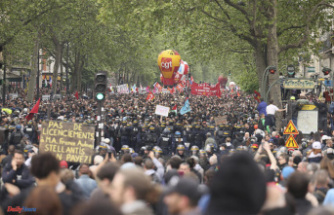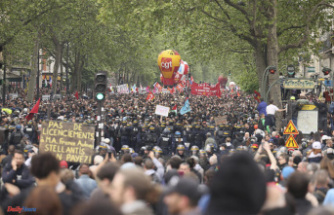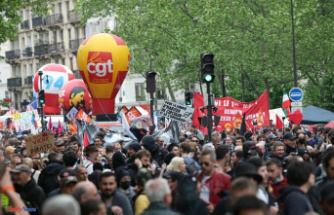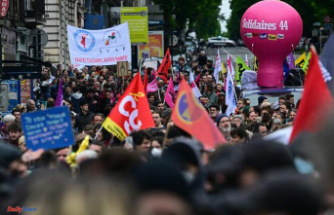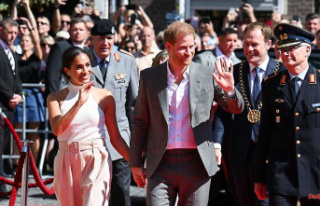Russian troops in Ukraine are increasingly short of weapons, ammunition and tanks. "It's getting quieter in the Donbass," says military economist Marcus Keupp ntv.de. While Ukraine is getting stronger through NATO arms deliveries, the Russian army is getting weaker and weaker.
Russia apparently underestimated the military effort involved in the Ukraine war. According to British intelligence, only six months after the invasion, the Russian troops are struggling with dramatic supply problems with tanks, weapons and ammunition. Until now, it had been assumed that Kremlin chief Vladimir Putin could fall back on huge armaments stocks from the Soviet Union. "However, if we look at what is actually operational, the numbers look much smaller," says military economist Marcus Keupp ntv.de.
The lecturer at the Military Academy at ETH Zurich gives an example: Before the war, Russia had around 2,700 operational tanks. After 6 months in Ukraine the troops have lost around 1000 of them, giving a loss rate of 5 tanks per day. Extrapolated into the future, this means that "in a year at the latest, the Russian army will no longer have any tanks if the wear and tear continues," says Keupp. According to the military expert, there has never been such a high casualty rate in European war history, "not even in World War II."
Keupp doubts that the Soviet stocks can provide a significant replacement here. On the one hand, because there is a good chance that these "partly only consist of scrap metal". On the other hand, because Russia is increasingly lacking soldiers. "Soldiers in a tank hardly have a chance of escaping alive if they are fired upon with a Stinger, Javelin or a drone attack at night," explains Keupp. Putin recently increased his army by decree by 137,000 soldiers. What is missing, however, are "motorized rifle divisions that have been trained for years". According to Keupp, volunteers could drive the tanks, but not fight tactically.
So the question arises as to how quickly Russian industry can provide armaments supplies in Ukraine. Pavel Luzin, a Russian expert on international relations and Russia's defense, thinks it is "unlikely that Russian industry has the potential to seriously ramp up production." From his point of view, this is mainly due to the low productivity within the companies. A "dramatic increase in headcount" could only theoretically improve performance, Luzin said. In practice, however, this fails due to the lack of personnel in Russia, is the result of his analysis, which is quoted by the Russian platform The Insider.
In mid-July, Putin signed a law to convert the country to a war economy. According to Keupp, however, it was little more than "a desperate attempt to fire up the Russian defense industry." The armaments industry is said to be too slow and too heavily indebted. Russia currently manages to produce around 100 tanks a year "with late 1980s technology." "With a loss of five tanks a day, that won't do the army much good," is the verdict of the expert.
Russia's industry is therefore having immense difficulties in absorbing the high material losses in the Ukraine war. The troops are already lacking guided missiles, writes Luzin at The Insider. And that should not be the end: "If the intensity of the war remains at this level, Moscow will also be faced with a noticeable shortage of shells by the end of 2022."
"This is the First World War reloaded," Keupp describes it to ntv.de. The German army also started 1914/15 with rapid troop movements on the western front. At the time, Germany was also not prepared to produce a large number of grenades, so they had to be rationed as a result. "This is exactly what is happening in Ukraine now," says the military economist. Until the end of July, Russian troops fired around 50,000 artillery shells a day. "Now things are slowly getting quiet in the Donbass."
Apparently, not only the Russian shells and tanks, but also the cannons are running out. According to Keupp, there is a new observation that Russian troops in Ukraine have been using anti-aircraft systems as artillery to keep up the fire since last week. Militarily, however, "that's the stupidest thing you can do". Because they are actually intended to shoot down enemy planes. "They are expensive and difficult to produce," says Keupp.
But apparently Moscow no longer has any other choice: reserves are running low, its own armaments industry cannot keep up, and there is no sign of any significant support from abroad. According to the Washington Post, Iran recently delivered some drones. But they will probably not be able to absorb the high losses either - especially since the deliveries were apparently even faulty. According to the latest media reports citing US secret services, Russia is apparently now also getting artillery ammunition and grenades from North Korea because of Western sanctions. This, too, is taken by US officials as an indication that the army is on the decline and that it is becoming increasingly difficult for Russia to maintain its invasion of Ukraine.
The best strategy for the Russian army in Ukraine would be to retreat to consolidate, says Keupp. However, Putin would thereby admit his failure. "And because he can't do that, his troops try to proceed as brutally as possible, regardless of the casualties."
In fact, Kremlin troops have not reported any gains in territory for the first time since mid-August. "Russia still has artillery superiority," says Keupp. But the Ukrainian army is getting stronger thanks to the arms deliveries from NATO, while Russia can only use up its reserves. "I would say in four weeks we'll be roughly equal."



